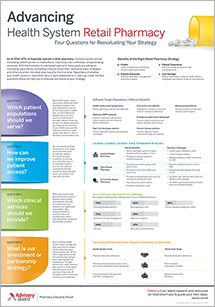For drugmakers, the process of choosing a new pill's color is surprisingly fraught and high-stakes—and "can help propel a tiny pill into a billion-dollar franchise," Jacob Bell reports for BioPharma Dive.
What executives need to know about pharmacy
The little blue pill
While color might seem like a small detail, it can make all the difference in a new medication's marketing.
Some of the most well-known, lucrative prescription drugs are recognizable by their color. For instance, consumers associate Pfizer's Viagra, which treats erectile dysfunction, with its blue pill and packaging. Similarly, Nexium and Prilosec, both stomach medications made by AstraZeneca, are known for their purple color.
How drugmakers pick a color
Deciding on a color to represent the brand can be a complicated process, Bell reports.
One factor drugmakers consider is how consumers—and physicians—will perceive the drug, Bell reports. Research suggests that patients are more likely to purchase or take a medication when the color reflects the desired effect.
For instance, warm colors might "appear stimulating," Bell writes, while a cool palette can "imply sedation." For that reason, drugmakers of migraine prevention treatment often use "soothing cool tones" and colors that induce calm in their advertising, Bell reports.
Similarly, Dave Traini, creative director at health care advertising agency Sentrix Health, noted, "If you have ... a dermatology product for psoriasis, you're not going to make the color red because that reminds people of inflammation." He added, "You're not going to use the color yellow for something treating an infection because that reminds you of puss."
Edging out the competition
A drugmakers' competitors also play a role the color a company selects to represent their brand. Drugmakers typically avoid choosing the same color palette as competing drug brands, Bell reports.
"If you have a big competitor in your category that is the orange brand, you're not going to go out and have orange be your primary color," Traini said. "So you do want to be mindful of what else has already been taken in that therapeutic category."
For instance, because Pfizer was marketing Viagra as a blue pill, Eli Lilly decided to make erectile dysfunction medication, Cialis, orange.

6 ways your pharmacist can save the day
"[Viagra's] blue ... connotes sort of a feeling of calm," Jeanne Ryan, principal of life sciences advertising firm ZS, said. "Then [Cialis] came out afterwards [and] took advantage of that and said: We don't want to be calm, we're about virility, and so we want to be the anti-blue pill."
Lilly did not comment on its approach to marketing Cialis, Bell reports.
The deciding factors may not be what you expect
Regulatory requirements also can influence—or impede—what color a drugmaker selects.
For instance, one country might restrict pharmaceutical use of a company's desired color, which forces the drugmaker to choose another, Bell reports.
And sometimes, a drugmaker's internal processes ultimately drive a pill's color. Once, Ryan's agency conducted an extensive review to recommend a color for a new pill, researching storage and handling, patient preferences, and regulatory requirements.
Ultimately, though, the client stuck with a plain, dull white—in part because her contact at the drugmaker wasn't responsible for the drug's advertising. "One of the stated reasons why they stuck with white was that it wasn't their job to commercialize this drug, it wasn't their job to decide how to position it," Ryan explained (Bell, BioPharma Dive, 10/29/18).
What executives need to know about pharmacy
While historically pharmacy may have been viewed as a cost center, today pharmacy services generate a significant portion of system revenues and are essential to the achievement of strategic system-level priorities.
To better understand increasingly complex pharmacy issues and the critical role pharmacy plays in overall health system success, download our executive briefings on hot pharmacy topics.
Don't miss out on the latest Advisory Board insights
Create your free account to access 1 resource, including the latest research and webinars.
Want access without creating an account?
You have 1 free members-only resource remaining this month.
1 free members-only resources remaining
1 free members-only resources remaining
You've reached your limit of free insights
Become a member to access all of Advisory Board's resources, events, and experts
Never miss out on the latest innovative health care content tailored to you.
Benefits include:
You've reached your limit of free insights
Become a member to access all of Advisory Board's resources, events, and experts
Never miss out on the latest innovative health care content tailored to you.
Benefits include:
This content is available through your Curated Research partnership with Advisory Board. Click on ‘view this resource’ to read the full piece
Email ask@advisory.com to learn more
Click on ‘Become a Member’ to learn about the benefits of a Full-Access partnership with Advisory Board
Never miss out on the latest innovative health care content tailored to you.
Benefits Include:
This is for members only. Learn more.
Click on ‘Become a Member’ to learn about the benefits of a Full-Access partnership with Advisory Board
Never miss out on the latest innovative health care content tailored to you.


